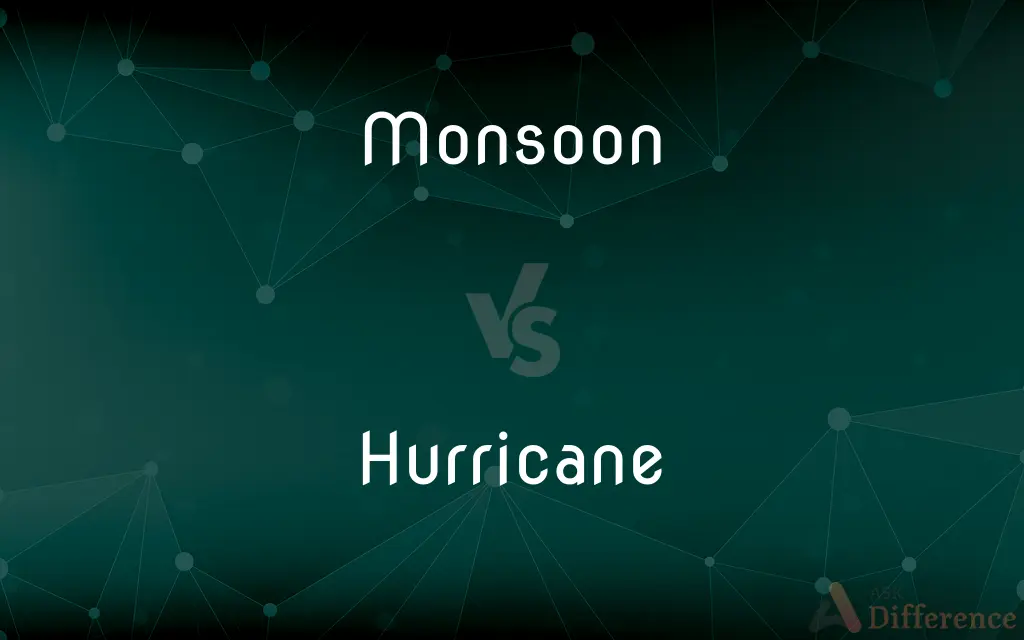Monsoon vs. Hurricane — What's the Difference?
By Tayyaba Rehman — Updated on August 20, 2023
Monsoons are seasonal wind patterns causing heavy rainfall, while hurricanes are powerful tropical storms with strong winds, rain, and storm surges.

Difference Between Monsoon and Hurricane
Table of Contents
ADVERTISEMENT
Key Differences
Monsoons refer to seasonal shifts in wind patterns that result in significant weather changes, typically bringing heavy rainfall. These wind shifts usually happen over large regions, such as the Indian subcontinent or Southeast Asia. In contrast, hurricanes are intense tropical cyclones that form over warm ocean waters, often in the Atlantic or Eastern Pacific regions.
Monsoons are often welcomed in many regions as they provide much-needed rainfall for agriculture. This heavy rainfall can last for weeks or even months, replenishing groundwater and feeding rivers and lakes. Hurricanes, on the other hand, are short-lived, lasting only a few days to a couple of weeks. They are known for their destructive nature, causing flooding, storm surges, and wind damage.
The onset of a monsoon is predictable and is an annual event for many countries, often commencing at roughly the same time each year. While they can cause flooding, they're an essential part of the regional climate system. Hurricanes, in contrast, are unpredictable in their formation and path, often leaving communities with little time to prepare for their devastating impacts.
Monsoon winds typically have a steady direction and intensity, influenced by larger atmospheric conditions such as the position of the jet stream or the Intertropical Convergence Zone. Hurricanes, meanwhile, are characterized by their swirling wind patterns, with a calm "eye" at the center surrounded by a wall of severe storms.
Comparison Chart
Nature
Seasonal wind pattern
Powerful tropical storm
ADVERTISEMENT
Duration
Weeks to months
Days to a couple of weeks
Predictability
Annual and predictable
Unpredictable in formation and path
Geographical Scope
Large regions (e.g., South Asia)
Specific ocean areas (e.g., Atlantic)
Main Impact
Heavy rainfall
Strong winds, rain, storm surges
Compare with Definitions
Monsoon
A wind from the southwest or south that brings heavy rainfall to southern Asia in the summer.
Hurricane
A severe tropical cyclone having winds greater than 64 knots (74 miles per hour; 119 kilometers per hour), originating in the equatorial regions of the Atlantic Ocean or Caribbean Sea or eastern regions of the Pacific Ocean, traveling north, northwest, or northeast from its point of origin, and usually involving heavy rains.
Monsoon
Monsoons are winds that reverse direction between winter and summer.
The change in monsoon winds signifies the arrival of the rainy season.
Hurricane
A hurricane is a powerful storm characterized by strong winds and heavy rainfall.
The hurricane left a trail of destruction in its wake.
Monsoon
A monsoon is a seasonal shift in wind patterns leading to heavy rainfall.
The monsoon season is crucial for farmers in India.
Hurricane
A severe tropical cyclone in the North Atlantic Ocean, Caribbean Sea, Gulf of Mexico, or in the eastern North Pacific off the west coast of Mexico, with winds of 119 km/h (74 miles per hour) or greater accompanied by rain, lightning, and thunder that sometimes moves into temperate latitudes.
Monsoon
They stem from temperature differences between land and sea.
The monsoon winds gain moisture from the ocean before reaching the coast.
Hurricane
They are ranked in categories based on wind speed.
The hurricane was upgraded to a category 4 as it approached land.
Monsoon
Tropical rainy season when the rain lasts for several months with few interruptions.
Hurricane
They feature a calm eye in the center surrounded by a stormy exterior.
The eye of the hurricane passed over, giving a brief respite from the storm.
Monsoon
A wind system that influences large climatic regions and reverses direction seasonally.
Hurricane
A wind with a speed greater than 64 knots (74 miles per hour; 119 kilometers per hour per hour), according to the Beaufort scale.
Monsoon
A similar seasonal wind, as in the southwest United States, that brings increased rainfall.
Hurricane
Something resembling a hurricane in force or speed.
Monsoon
The rain that comes with any of these winds or wind systems.
Hurricane
(meteorology) A wind scale for quite strong wind, stronger than a storm
Monsoon
The rains themselves.
Hurricane
"full—triple-full—full" – an acrobatic maneuver consisting of three flips and five twists, with one twist on the first flip, three twists on the second flip, one twist on the third flip
Monsoon
The season in which the monsoon{2} occurs.
Hurricane
A violent storm, characterized by extreme fury and sudden changes of the wind, and generally accompanied by rain, thunder, and lightning; - especially prevalent in the East and West Indies. Also used figuratively.
Like the smoke in a hurricane whirl'd.
Each guilty thought to me isA dreadful hurricane.
Monsoon
A seasonal wind in southern Asia; blows from the southwest (bringing rain) in summer and from the northeast in winter
Hurricane
A severe tropical cyclone usually with heavy rains and winds moving a 73-136 knots (12 on the Beaufort scale)
Monsoon
Any wind that changes direction with the seasons
Hurricane
Hurricanes are tropical cyclones originating over warm ocean waters.
The warm waters of the Gulf of Mexico can fuel hurricanes.
Monsoon
It is a climatic phenomenon marked by well-defined wet and dry seasons.
The monsoon rains rejuvenated the parched land.
Hurricane
Hurricanes can cause significant damage from wind, rain, and storm surges.
Coastal towns often bear the brunt of a hurricane's fury.
Monsoon
Any of a number of winds associated with regions where most rain falls during a particular season.
Monsoon
Entire meteorological systems with such characteristics.
Monsoon
A wind blowing part of the year from one direction, alternating with a wind from the opposite direction; - a term applied particularly to periodical winds of the Indian Ocean, which blow from the southwest from the latter part of May to the middle of September, and from the northeast from about the middle of October to the middle of December.
Monsoon
A heavy rainfall in India associated with the southwest monsoon{1}.
Monsoon
Rainy season in southern Asia when the southwestern monsoon blows, bringing heavy rains
Monsoon
Monsoons are critical for the agricultural and economic health of many countries.
The delayed monsoon impacted the crop yield this year.
Common Curiosities
What is a monsoon?
Monsoons are seasonal wind shifts that typically result in heavy rainfall and are integral to the climate of regions like South Asia.
Is there a specific time for monsoons?
Monsoons usually occur annually, with their onset and duration being relatively predictable for specific regions.
What causes monsoons?
Monsoons arise from temperature differences between continents and oceans, leading to large-scale shifts in wind patterns.
How are monsoons beneficial?
Monsoons provide essential rainfall to many regions, supporting agriculture, replenishing water sources, and impacting the local economy.
How do hurricanes form?
Hurricanes develop over warm ocean waters when moist air rises, creating a system of winds and storms.
What is a hurricane?
Hurricanes are powerful tropical cyclones characterized by intense winds, heavy rains, and the potential to cause significant damage.
Can monsoons be harmful?
While vital, monsoons can lead to flooding, landslides, and other disasters if the rainfall is excessive.
What areas are most affected by hurricanes?
Regions such as the Atlantic Coast of the U.S., the Caribbean, and parts of Southeast Asia often experience hurricanes.
How are hurricanes categorized?
Hurricanes are categorized by their wind speeds, with Category 5 being the most severe and indicative of winds greater than 157 mph.
How can one prepare for a hurricane?
Preparation includes securing property, having an evacuation plan, stocking emergency supplies, and staying informed via local news or weather channels.
Share Your Discovery

Previous Comparison
Oedema vs. Edema
Next Comparison
Souvlaki vs. GyroAuthor Spotlight
Written by
Tayyaba RehmanTayyaba Rehman is a distinguished writer, currently serving as a primary contributor to askdifference.com. As a researcher in semantics and etymology, Tayyaba's passion for the complexity of languages and their distinctions has found a perfect home on the platform. Tayyaba delves into the intricacies of language, distinguishing between commonly confused words and phrases, thereby providing clarity for readers worldwide.













































